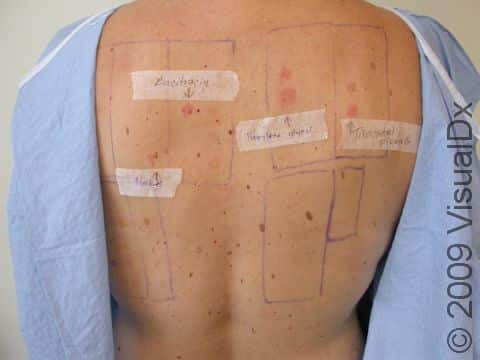Patch Testing for Skin Contact Allergy
Inflammation of the skin, known as contact dermatitis, can result if a person is allergic to a substance that touches their skin. Patch testing is a common procedure used by medical professionals such as dermatologists and allergists to help determine if a dermatitis is caused by a contact allergy. Patch testing, along with a careful evaluation of a person’s exposures in addition to the location and pattern of any rash on the body, can help determine the underlying allergen or allergens.
Contact dermatitis is commonly caused by:
- Use of prescription or nonprescription products applied to the skin, including topical ointments, creams, and lotions.
- Exposure to metals (eg, nickel, which can be found in jewelry, belts, buttons).
- Chemicals such as paraphenylenediamine found in hair dye.
- Fragrances found in perfumes and detergents.
- Preservatives such as thimerosal found in contact lens solution.
- Rubber ingredients such as latex.
What to Expect During Your Visit
The medical professional performing the patch test will determine which allergens to test. This usually includes a standard selection of common allergens that are responsible for the most allergic skin reactions as well as any specific allergens that may be causing your dermatitis. Once the allergen selection is prepared, small plastic or aluminum discs are placed on your upper back in an area of skin unaffected by any current rash, and adhesive tape is used to secure the discs.
The adhesive tape and discs are removed 48 hours later, and the skin is examined to assess for any response to the allergens. A second examination is performed 4-7 days later.
During the time the allergen patches are in direct contact with your skin, avoid vigorous activity or washing the area. Also avoid sun exposure during this time.
What to Expect After Your Visit
When patch testing is completed, a record of the result is typically provided to explain which allergens to avoid and the products in which these allergens may be found. Avoiding these allergens in the future can help eliminate, or at least help improve, your skin inflammation. Note that the first patch testing may not always explain the cause of the dermatitis. In this case, your medical professional may recommend further patch testing or deem the dermatitis not to be caused by a contact allergen.
Follow-Up Care
Following patch testing, you may care for your skin with gentle soap and water. If your medical professional prescribes a topical steroid cream for your back to reduce the skin reaction caused by a positive patch test, be sure to use the cream as directed.
Risks and Potential Side Effects
The most common effect is skin irritation or dermatitis at the test area. There may also be some skin discoloration at the sites where the patches were applied. An exaggerated allergic or irritant skin reaction may sometimes occur at the site of patch testing, including a rash and a burn-like reaction. In rare cases, the patches can cause severe allergic reaction, usually within the first 30 minutes of patch testing.
When to Seek Medical Care
Seek medical care following patch testing in the case of a severe rash or a burn-like reaction. If you have trouble breathing following patch testing, seek emergency medical care.
References
Fiessinger LA, Jaimes J, Soutor C. Diagnostic Procedures and Dermoscopy. In: Soutor C, Hordinsky MK, eds. Clinical Dermatology: Diagnosis and Management of Common Disorders. 2nd ed. McGraw Hill; 2022.
Ludmann P, Mahmoud BH, Hawryluk E, Stone S. Patch testing can find what’s causing your rash. AAD. https://www.aad.org/public/diseases/eczema/types/contact-dermatitis/patch-testing-rash. Updated 2021 Mar 15. Accessed 2024 April 22.
Turrentine JE, Sheehan MP, Cruz, Jr. PD. Allergic Contact Dermatitis. In: Kang S, Amagai M, Bruckner AL, Enk AH, Margolis DJ, McMichael AJ, Orringer JS, eds. Fitzpatrick’s Dermatology. 9th ed. New York, NY: McGraw-Hill Education; 2019.
Last modified on May 10th, 2024 at 10:58 am

Not sure what to look for?
Try our new Rash and Skin Condition Finder
